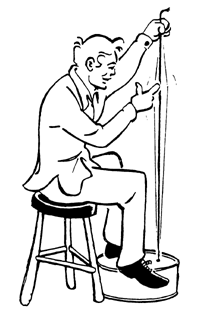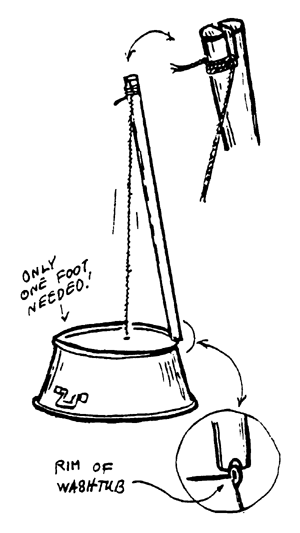
Simple Musical Instruments
Ellen Kuhfeld
The biggest problem in any new endeavor is performance anxiety. "Will it be any good? What if I work for a month, and people laugh at the results?" Well, it's true -- a sandlot ballplayer might collect laughter if dropped into the World Series. So play sandlot until you're ready for that World Series. Make folk instruments before you tackle the violin!
Real success is worth ten pep talks. Let's start by doing a few experiments. Then we can build the simplest musical instruments you'll ever meet. We'll need:
• Several yards of stout line (thick string, thin twine, or 30-Ib nylon fishing monofilament).
• Tin cans -- a large one (a coffee can, or one of the big flat cans that cookies and candy come in) and a small one (tuna-fish, water chestnut, pineapple rings).
• A straight dowel, a yard long and about 3/4" diameter. Cut a notch on one end, and a slot in the other in line with the notch (see drawing of washtub bass).
• A few tools and sundries -- a small hammer, a sturdy razor-knife, a brad (small nail) an inch and a half long, a small scrap of wood.
Take a yard of line. Bite one end in your teeth, and pull on the other end. Strum the string. You hear a musical note. The harder you pull, the higher the note is. If you use lighter, thinner line, the same pull will get you a higher note still. Now take three yards of line, and have a friend pull on the far end. The note is deeper.
The string vibrates, quietly. It jiggles your teeth, and the bones of your skull carry the vibrations to your inner ear. It's a very personal music -- it happens inside your head, literally. But if you want to perform, an audience cannot bite your guitar! How to get the sound to them?
Drop the brad on the floor. You hear almost nothing. Drop it on the end of your large tin can, and it's loud. Fasten a string to the can and pluck it, and you hear a musical note. A moving object (the falling brad, a vibrating string) can move a large area of something flat. As the end of the can jiggles, it sets the air to jiggling too. That's sound, which anybody in the room can hear.
The Washtub Bass
So the simplest musical instrument an audience can hear is a tin can with a taut string fastened
to the end. The musician controls the tightness (and thus the note) by pulling the string with one
hand. The other hand strums, while both feet hold the can down.
Jug bands use a similar instrument, the washtub bass. It has only one refinement: a stick between the rim of the washtub and the far end of the string. That frees one foot from holding the washtub down, and simplifies holding the string at a well-controlled tension. Adding the dowel to the can will give you a small version of this instrument. The notch in one end of the dowel goes over the rolled edge of the tin. The string is tied into the slit in the other end. The player controls the notes by moving the stick back-and-forth to change the tension on the string.
The Mouth-Bow and Beyond
The washtub bass exists, but it's an uncooperative instrument. Most stringed instruments use tension adjustment only in tuning, or for tiny changes -- a guitar string pulled sideways across the fret, a pedal steel guitar going up and down half a note. The most common way of playing melodies is by adjusting the vibrating length of the string.
Pound your brad into the notched end of the dowel. Tie a loop in one end of your line and hook it on the nail. (Monofilament fishline works best for this one.) Pull the string as tight as you can, and fasten it in the slot. Now pluck the string - - and it doesn't vibrate. It's flat against the dowel. (What? You say it's not flat -- the dowel curves a bit? I said get a straight dowel! We're trying to make a point here.)
Whittle a small wedge from your scrap of wood, a quarter or a third of an inch in dimensions. Put it between the dowel and the string, near one end. With the string propped away from the dowel, we can pluck it and hear a quiet musical tone. If we bite the dowel, the tone is much louder. We can effectively shorten the string by holding it against the dowel. This lets us play simple tunes by moving our hand up and down its length.
You've made a mouth-bow. It's an improvised instrument found wherever bows and arrows are used. Some claim you can use your mouth as a resonating chamber by pressing the bow against your cheek. This makes the sound loud enough for a small audience. I've never been able to -- but a tuna-fish tin does the job.
Untie the string from your dowel, and remove the brad from the end. Punch a hole in the tuna can, half the diameter of your dowel from the covered end. (You can use the brad.) Use the razor knife to cut a cross in the metal. Push the points into the can, and shove the dowel into the hole. Across from the hole, pound your brad through the metal and into the dowel. Loop your string over the brad, and again fasten it tightly to the slot. Now put the wedge between the string and the tin, and strum -- behold, there is music your audience can hear!
Next: the Tuna-Tin Banjo